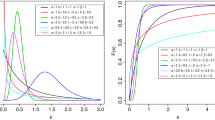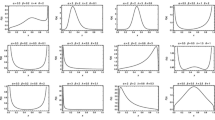Abstract
This note is concerned with a broad family of univariate distributions, namely the class of the beta-generated distributions which is created on the basis of the beta distribution by incorporating on this classic model a parent distribution function F with respective density f. The class of beta-generated distributions have received a great attention in the recent literature on distribution theory. The aim of this note is to provide with some properties and characterizations of the beta-generated distributions which are already known from the theory of order statistics.
It is a great honor to present this work to the memory of my beloved friend Pedro Gil, an exceptional scientist and an outstanding human personality.
Access this chapter
Tax calculation will be finalised at checkout
Purchases are for personal use only
Similar content being viewed by others
References
Akinsete A, Famoye F, Lee C (2008) The beta-Pareto distribution. Statistics 42:547–563
Alexander C, Sarabia JM (2010) Generalized beta generated distributions. ICMA centre discussion papers in finance DP2010-09
Alexander C, Cordeiro GM, Ortega EMM, Sarabia JM (2012) Generalized beta-generated distributions. Comput Stat Data Anal 56:1880–1897
Aliprantis CD, Burkinshaw O (1998) Principles of real analysis. Academic Press, San Diego
Alzaatreh A, Lee C, Famoye F (2014) The gamma-normal distribution: properties and applications. Comput Stat Data Anal 69:67–80
Asadi M, Ebrahimi N, Hamedani GG, Soofi E (2006) Information measures for Pareto distributions and order statistics. In: Balakrishnan N, Castillo E, Sarabia JM (eds) Advances in distribution theory, order statistics, and inference. Birkhäuser, Boston
Baratpour S, Ahmadi J, Arghami NR (2007) Some characterizations based on entropy of order statistics and record values. Commun Stat-Theor Meth 36:47–57
Barreto-Souza W, Santos AHS, Cordeiro GM (2010) The beta generalized exponential distribution. J Stat Comput Simul 80:159–172
Cordeiro GM, de Castro M (2011) A new family of generalized distributions. J Stat Comput Simul 81:883–893
Eugene N, Lee C, Famoye F (2002) Beta-normal distribution and its applications. Commun Stat Theor Meth 31:497–512
Gradshteyn IS, Ryzhik IM (1965) Table of integrals series and products. Academic Press, New York
Jones MC (2004) Families of distributions arising from distributions of order statistics. Test 13:1–43
Kullback S (1959) Information theory and statistics. Wiley, New York
Lee C, Famoye F, Alzaatreh A (2013) Methods for generating families of continuous distribution in the recent decades. WIREs Comput Stat 5:219–238
Nadarajah S, Kotz S (2006) The beta exponential distribution. Reliab Eng Syst Saf 91:689–697
Paranaiba PF, Ortega EMM, Cordeiro GM, Pescim RR (2010) The beta burr XII distribution with application to lifetime data. Comput Stat Data Anal 55:1118–1136
Zografos K (2008) On some beta generated distributions and their maximum entropy characterization: the beta-Weibull distribution. In: Barnett NS, Dragomir SS (eds) Advances in inequalities from probability theory & statistics. Nova Science Publishers, New Jersey
Zografos K (2011) Generalized beta generated-II distributions. In: Pardo L, Balakrishnan N, Gil MA (eds) Modern mathematical tools and techniques in capturing complexity. Springer, Berlin
Zografos K, Balakrishnan N (2009) On families of beta- and generalized gamma- generated distributions and associated inference. Stat Meth 6:344–362
Author information
Authors and Affiliations
Corresponding author
Editor information
Editors and Affiliations
5 Appendix: Proof of Proposition 2.2
5 Appendix: Proof of Proposition 2.2
\(\left( \Longrightarrow \right) \) Suppose that \(r_{\theta }(x)= \frac{f_{\theta }(x)}{1-F_{\theta }(x)}=w(\theta ),\theta \in \varTheta \subseteq \mathbb {R}\). Then,
or
Taking into account that \(B(1,1)=1\) and using Lemma 1(b) of Zografos and Balakrishnan [19], we get
Based on
(cf. Gradshteyn and Ryzhik [11, §. 365]), it is obtained that,
On the other hand,
and taking into account that \(r_{\theta }(x)=w(\theta )\) and \(B(1,\beta )=1/\beta \) it is obtained that
Using again Lemma 1(b) of Zografos and Balakrishnan [19] and Eq. (7) above,
Equations (8) and (10) lead now to the desired result.
\(\left( \Longleftarrow \right) \) Suppose that \(\mathscr {H} _{Sh}(f_{\theta })-\mathscr {H}_{Sh}(g_{F_{\theta }}^{1,\beta })=\ln \beta \), for \(\beta \ge 1.\) Based on (9) and on the identity \(B(1,\beta )=1/\beta ,\)
Using Lemma 1(b) of Zografos and Balakrishnan [19] and Eq. (7), we obtain
Then, the above formula for \(\mathscr {H}_{Sh}\left( g_{F_{\theta }}^{1,\beta }\right) \) is simplified as follows,
Because, by hypothesis, \(\mathscr {H}_{Sh}(f_{\theta })-\mathscr {H} _{Sh}(g_{F_{\theta }}^{1,\beta })=\ln \beta \), using the previous expression for \(\mathscr {H}_{Sh}\left( g_{F_{\theta }}^{1,\beta }\right) \), it is obtained
Applying the transformation \(u=1-F_{\theta }(x)\) to the last integral
Equations (11) and (12) lead to
and taking into account that \(\mathscr {H}_{Sh}(f_{\theta })\) does not depend on x or u,
In view of Exercise 4 of Aliprantis and Burkinshaw (see [4, p. 90]) for \( n=\beta -1, n \ge 0,\) it is obtained that
The result now follows by using a similar argument as that of the last two lines in the proof of Theorem 2.1 of Barapour et al. [7]. \(\square \)
Rights and permissions
Copyright information
© 2018 Springer International Publishing AG
About this chapter
Cite this chapter
Zografos, K. (2018). On Some Properties of Beta-Generated Distributions. In: Gil, E., Gil, E., Gil, J., Gil, M. (eds) The Mathematics of the Uncertain. Studies in Systems, Decision and Control, vol 142. Springer, Cham. https://doi.org/10.1007/978-3-319-73848-2_50
Download citation
DOI: https://doi.org/10.1007/978-3-319-73848-2_50
Published:
Publisher Name: Springer, Cham
Print ISBN: 978-3-319-73847-5
Online ISBN: 978-3-319-73848-2
eBook Packages: EngineeringEngineering (R0)




